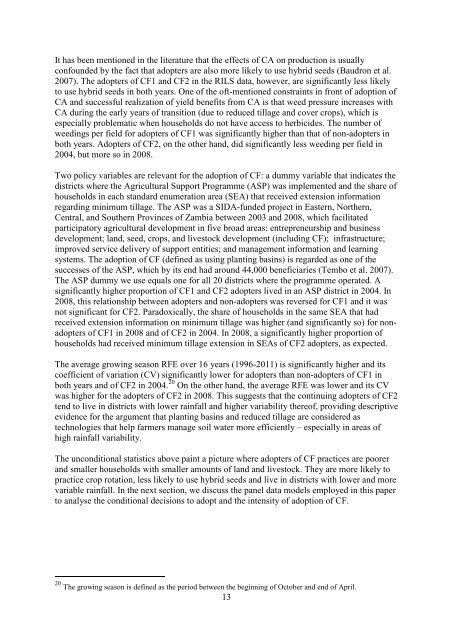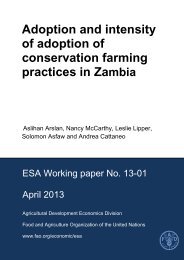Adoption and intensity of adoption of conservation farming practices in Zambia
Adoption and intensity of adoption of conservation farming practices in Zambia
Adoption and intensity of adoption of conservation farming practices in Zambia
You also want an ePaper? Increase the reach of your titles
YUMPU automatically turns print PDFs into web optimized ePapers that Google loves.
It has been mentioned <strong>in</strong> the literature that the effects <strong>of</strong> CA on production is usually<br />
confounded by the fact that adopters are also more likely to use hybrid seeds (Baudron et al.<br />
2007). The adopters <strong>of</strong> CF1 <strong>and</strong> CF2 <strong>in</strong> the RILS data, however, are significantly less likely<br />
to use hybrid seeds <strong>in</strong> both years. One <strong>of</strong> the <strong>of</strong>t-mentioned constra<strong>in</strong>ts <strong>in</strong> front <strong>of</strong> <strong>adoption</strong> <strong>of</strong><br />
CA <strong>and</strong> successful realization <strong>of</strong> yield benefits from CA is that weed pressure <strong>in</strong>creases with<br />
CA dur<strong>in</strong>g the early years <strong>of</strong> transition (due to reduced tillage <strong>and</strong> cover crops), which is<br />
especially problematic when households do not have access to herbicides. The number <strong>of</strong><br />
weed<strong>in</strong>gs per field for adopters <strong>of</strong> CF1 was significantly higher than that <strong>of</strong> non-adopters <strong>in</strong><br />
both years. Adopters <strong>of</strong> CF2, on the other h<strong>and</strong>, did significantly less weed<strong>in</strong>g per field <strong>in</strong><br />
2004, but more so <strong>in</strong> 2008.<br />
Two policy variables are relevant for the <strong>adoption</strong> <strong>of</strong> CF: a dummy variable that <strong>in</strong>dicates the<br />
districts where the Agricultural Support Programme (ASP) was implemented <strong>and</strong> the share <strong>of</strong><br />
households <strong>in</strong> each st<strong>and</strong>ard enumeration area (SEA) that received extension <strong>in</strong>formation<br />
regard<strong>in</strong>g m<strong>in</strong>imum tillage. The ASP was a SIDA-funded project <strong>in</strong> Eastern, Northern,<br />
Central, <strong>and</strong> Southern Prov<strong>in</strong>ces <strong>of</strong> <strong>Zambia</strong> between 2003 <strong>and</strong> 2008, which facilitated<br />
participatory agricultural development <strong>in</strong> five broad areas: entrepreneurship <strong>and</strong> bus<strong>in</strong>ess<br />
development; l<strong>and</strong>, seed, crops, <strong>and</strong> livestock development (<strong>in</strong>clud<strong>in</strong>g CF); <strong>in</strong>frastructure;<br />
improved service delivery <strong>of</strong> support entities; <strong>and</strong> management <strong>in</strong>formation <strong>and</strong> learn<strong>in</strong>g<br />
systems. The <strong>adoption</strong> <strong>of</strong> CF (def<strong>in</strong>ed as us<strong>in</strong>g plant<strong>in</strong>g bas<strong>in</strong>s) is regarded as one <strong>of</strong> the<br />
successes <strong>of</strong> the ASP, which by its end had around 44,000 beneficiaries (Tembo et al. 2007).<br />
The ASP dummy we use equals one for all 20 districts where the programme operated. A<br />
significantly higher proportion <strong>of</strong> CF1 <strong>and</strong> CF2 adopters lived <strong>in</strong> an ASP district <strong>in</strong> 2004. In<br />
2008, this relationship between adopters <strong>and</strong> non-adopters was reversed for CF1 <strong>and</strong> it was<br />
not significant for CF2. Paradoxically, the share <strong>of</strong> households <strong>in</strong> the same SEA that had<br />
received extension <strong>in</strong>formation on m<strong>in</strong>imum tillage was higher (<strong>and</strong> significantly so) for nonadopters<br />
<strong>of</strong> CF1 <strong>in</strong> 2008 <strong>and</strong> <strong>of</strong> CF2 <strong>in</strong> 2004. In 2008, a significantly higher proportion <strong>of</strong><br />
households had received m<strong>in</strong>imum tillage extension <strong>in</strong> SEAs <strong>of</strong> CF2 adopters, as expected.<br />
The average grow<strong>in</strong>g season RFE over 16 years (1996-2011) is significantly higher <strong>and</strong> its<br />
coefficient <strong>of</strong> variation (CV) significantly lower for adopters than non-adopters <strong>of</strong> CF1 <strong>in</strong><br />
both years <strong>and</strong> <strong>of</strong> CF2 <strong>in</strong> 2004. 20 On the other h<strong>and</strong>, the average RFE was lower <strong>and</strong> its CV<br />
was higher for the adopters <strong>of</strong> CF2 <strong>in</strong> 2008. This suggests that the cont<strong>in</strong>u<strong>in</strong>g adopters <strong>of</strong> CF2<br />
tend to live <strong>in</strong> districts with lower ra<strong>in</strong>fall <strong>and</strong> higher variability there<strong>of</strong>, provid<strong>in</strong>g descriptive<br />
evidence for the argument that plant<strong>in</strong>g bas<strong>in</strong>s <strong>and</strong> reduced tillage are considered as<br />
technologies that help farmers manage soil water more efficiently – especially <strong>in</strong> areas <strong>of</strong><br />
high ra<strong>in</strong>fall variability.<br />
The unconditional statistics above pa<strong>in</strong>t a picture where adopters <strong>of</strong> CF <strong>practices</strong> are poorer<br />
<strong>and</strong> smaller households with smaller amounts <strong>of</strong> l<strong>and</strong> <strong>and</strong> livestock. They are more likely to<br />
practice crop rotation, less likely to use hybrid seeds <strong>and</strong> live <strong>in</strong> districts with lower <strong>and</strong> more<br />
variable ra<strong>in</strong>fall. In the next section, we discuss the panel data models employed <strong>in</strong> this paper<br />
to analyse the conditional decisions to adopt <strong>and</strong> the <strong><strong>in</strong>tensity</strong> <strong>of</strong> <strong>adoption</strong> <strong>of</strong> CF.<br />
20 The grow<strong>in</strong>g season is def<strong>in</strong>ed as the period between the beg<strong>in</strong>n<strong>in</strong>g <strong>of</strong> October <strong>and</strong> end <strong>of</strong> April.<br />
13



